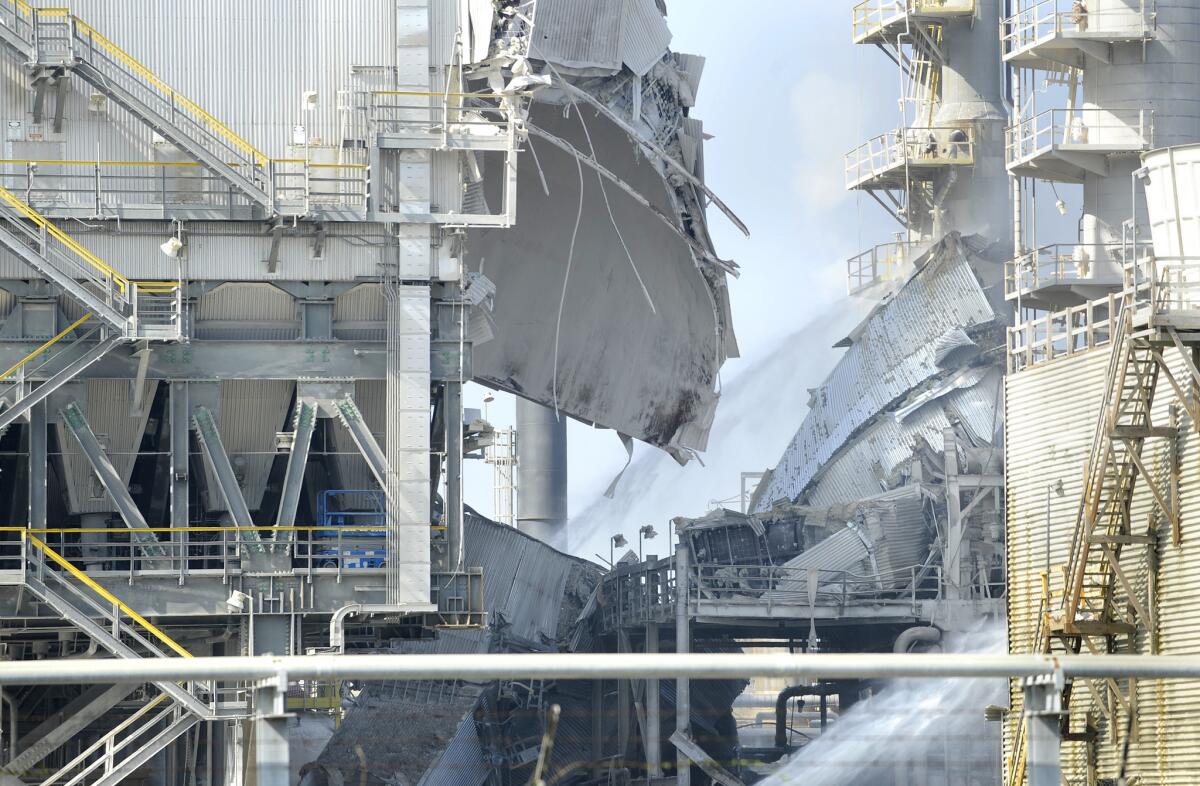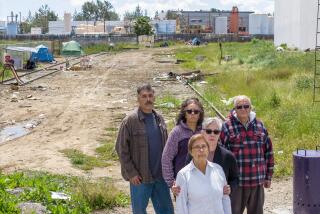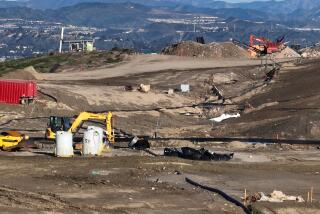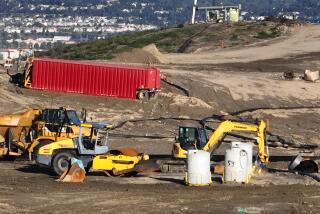Exxon Mobil’s outdated equipment and procedures led to Torrance explosion, agency says

Exxon Mobil Corp. relied on outdated procedures and used equipment that was older than its safe operating life, which led to a 2015 explosion at the Torrance refinery, endangering 150,000 nearby residents, a federal agency said Wednesday.
Workers at the oil refinery ran the facility “blind” leading up to the Feb. 18 explosion that largely shuttered the plant for more than a year, said Vanessa Allen Sutherland, chairwoman of the U.S. Chemical Safety Board. Gasoline prices soared following the explosion and stayed higher than normal for months.
Citing a 73-page report her agency released Wednesday, Sutherland said the explosion posed a threat to the community because highly toxic hydrofluoric acid was on site. The chemical, used at only two refineries in the state and about 50 nationwide, can immediately penetrate the skin and destroy tissue.
“The 2015 explosion had the potential to be catastrophic,” Sutherland said during a news conference Wednesday.
“At the Torrance refinery, workers did not have proper protocols to ensure safety when deviating from normal operating procedures,” she said. “Not only do procedures need to be on the books, but workers must be trained in them and management must put into practice what is on paper.”
The board recommended in its report that Exxon Mobil and other refiners ensure they update and review safety procedures; provide the guidelines in writing to appropriate plant personnel; and identify and evaluate all critical safety equipment.
Sutherland said her agency has sought more information about safety guidelines related to the refinery’s hydrofluoric acid but has not received the requested documents from Exxon Mobil. The agency is working with the U.S. Department of Justice for enforcement of the subpoenas it has issued to Exxon Mobil.
In response to the agency’s report, Exxon Mobil said there is no evidence that the Feb. 18, 2015, explosion posed any risk to the unit that contains hydrofluoric acid or harm to the community. The company said it “meets or exceeds accepted industry practices … and has stringent safety measures in place.”
Exxon Mobil also noted that it was cooperating with the Chemical Safety Board throughout the investigation conducted by that agency and others. Responses to investigators included 150 witness interviews — 65 with the Chemical Safety Board — and 137,000 pages of documents.
“Exxon Mobil deeply regrets the Feb. 18, 2015, incident at the Torrance refinery,” spokesman Todd Spitler said in a statement. “We are thankful that no one was seriously hurt.
“We are confident that we understand the cause of the Feb. 18 incident and have worked cooperatively with the Chemical Safety Board and staff to fully understand their findings and recommendations to improve the safety of our operations,” he said.
“The findings are horrifying,” said Sally Hayati, president of the Torrance Refinery Action Alliance who attended Wednesday’s news conference. “The refinery is not managed well. It’s dangerous.”
The 2015 explosion had the potential to be catastrophic.
— Vanessa Allen Sutherland, chairwoman, U.S. Chemical Safety Board
The conclusions and recommendations of the Chemical Safety Board, an agency set for possible elimination by the Trump administration, came as part of a release of its investigation report on the explosion.
Hayati said she is troubled that the existence of the Chemical Safety Board is being threatened because the agency provides the kind of reviews of major industries that residents need.
“The public needs this agency,” Hayati said. “It’s one of the few in which safety is truly number one. They have the force of science, reason and logic behind them.”
The Torrance refinery has been the focus of local, state and federal scrutiny since the 2015 explosion that destroyed a pollution-control unit. The lengthy outage at the plant caused gasoline prices in Southern California to jump as high as $1.50 above the national average.
During the outage, the plant, then owned by Exxon Mobil, operated at less than 20% of capacity. The Torrance refinery supplies 10% of the state’s refined gasoline capacity and 20% in Southern California.
In addition to gasoline, the refinery produces jet fuel, diesel fuel and other petroleum products. It covers 750 acres and employs approximately 650 employees and 550 contractors.
After repairing the refinery, Exxon Mobil sold the plant to New Jersey-based PBF Energy in July 2016.
New owner, new problems
Residents and critics of Exxon Mobil’s operations had hoped that PBF would run a safer refinery. But since PBF took over, the plant has endured one mishap after another, including temporary shutdowns, flaring and a fire.
The U.S. Environmental Protection Agency also identified safety concerns at the refinery in a report issued in March. EPA inspectors cited the refinery for safety systems and equipment that were “non-operational on a recurring basis,” incorrect identification of a flammable storage unit and failure to document who was responsible for the risk-management program.
During Wednesday’s news conference, the Chemical Safety Board specifically noted that since the 2015 explosion, the Torrance refinery has experienced multiple incidents under both Exxon Mobil and PBF, including:
- A Sept. 6, 2015, hydrofluoric acid leak;
- A Nov. 15, 2016, fire that occurred while work was being conducted on a portion of the refinery;
- A Feb. 1, 2017, fire that occurred in the Torrance refinery tank farm;
- A Feb. 18, 2017, pump-related fire that occurred in the crude unit.
“The CSB’s final report concludes that the refinery must adopt a robust safety management system in order to prevent future incidents,” said Mark Wingard, a Chemical Safety Board investigator. “Events at this facility keep occurring — adoption of the CSB’s safety recommendations will minimize the chances of future incidents.”
PBF Energy said it already has begun taking action to address the Chemical Safety Board’s concerns and recommendations.
“I think that the CSB report is really powerful in terms of what it said about Exxon Mobil,” said Jeff Dill, president of PBF Energy’s western region. “I really think we’ve moved the place forward.”
The company said it plans to complete two studies later this year that will help address all concerns.
“In addition, as part of our commitment to operating safely, reliably, and in an environmentally responsible manner, we are investing more than $100 million in a maintenance turnaround at Torrance to improve the refinery’s operational reliability,” said Michael Karlovich, a PBF Energy spokesman.
For more energy news, follow Ivan Penn on Twitter: @ivanlpenn
ALSO
Trump administration refuses to let Exxon Mobil drill for oil in Russia
Exxon Mobil is ordered to hand over climate change research
The role a melting glacier played in Exxon’s biggest disaster
UPDATES:
1:45 p.m.: This article was updated with comments from Sally Hayati, president of the Torrance Refinery Action Alliance.
This article was originally published at 12:20 p.m.







